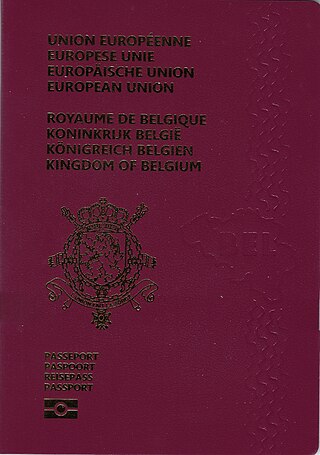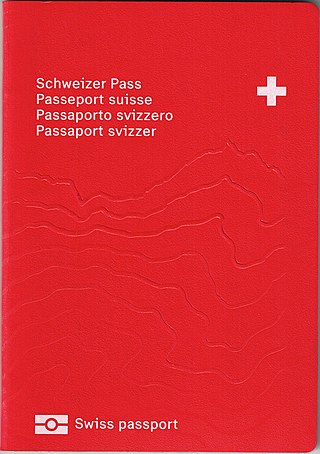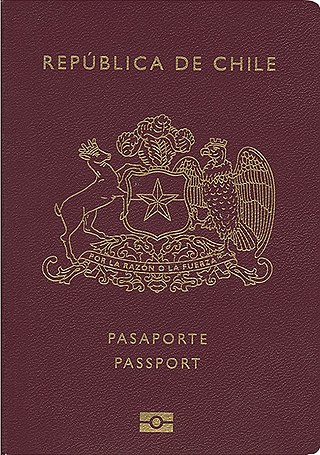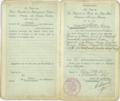
A biometric passport is a traditional passport that has an embedded electronic microprocessor chip, which contains biometric information that can be used to authenticate the identity of the passport holder. It uses contactless smart card technology, including a microprocessor chip and antenna embedded in the front or back cover, or centre page, of the passport. The passport's critical information is printed on the data page of the passport, repeated on the machine readable lines and stored in the chip. Public key infrastructure (PKI) is used to authenticate the data stored electronically in the passport chip, supposedly making it expensive and difficult to forge when all security mechanisms are fully and correctly implemented.

Croatian passport is issued to citizens of the Republic of Croatia for the purpose of international travel. The passport has the purpose of serving as proof of Croatian citizenship and identity. Responsibility for their issuance lies with the Ministry of the Interior; and for citizens abroad, passports are issued by the local embassy or consulate. Croatian passports are valid for ten or five years, and are not renewable. Every Croatian citizen is also a citizen of the European Union. The passport, along with the national identity card allows for free rights of movement and residence in any of the states of the European Economic Area and Switzerland.

A Philippine passport is both a travel document and a primary national identity document issued to citizens of the Philippines. It is issued by the Department of Foreign Affairs (DFA) and Philippine diplomatic missions abroad, with certain exceptions.

Thai passport is the passport issued to citizens and nationals of Thailand by the Passport Division of the Department of Consular Affairs within the Ministry of Foreign Affairs. Thai biometric passports have been issued since August 2005.

Greek passports are issued to Greek citizens for the purpose of international travel. Biometric passports have been issued since 26 August 2006, with old-style passports being declared invalid as of 1 January 2007. Since June 2009, the passport's RFID chip includes two index fingerprints as well as a high-resolution JPEG image of the passport holder. From 18 December 2023 the issuance of new generation of Greek passports started by selected authorities and after 9 January 2024, only the new generation of passports are issued. Every Greek citizen is also a citizen of the European Union. The passport, along with the national identity card allows for free rights of movement and residence in any of the states of the European Union, European Economic Area, and Switzerland.

A Bulgarian passport is an international travel document issued to nationals of Bulgaria, and may also serve as proof of Bulgarian citizenship. Besides enabling the bearer to travel internationally and serving as indication of Bulgarian citizenship, the passport facilitates the process of securing assistance from Bulgarian consular officials abroad or other European Union member states in case a Bulgarian consular is absent, if needed.

A Belgian passport is a travel document issued by Belgium to Belgian citizens to facilitate international travel. It grants the bearer international passage in accordance with visa requirements and serves as proof of citizenship.

A Swiss passport is the passport issued to citizens of Switzerland to facilitate international travel. Beside serving as proof of Swiss citizenship, they facilitate the process of securing assistance from Swiss consular officials abroad.

A Chilean passport is an identity document issued to citizens of Chile to facilitate international travel. Chilean passports are valid for worldwide travel and facilitate the access to consular services whilst abroad. They are issued by the Registro Civil e Identificación.

The European Union itself does not issue ordinary passports, but ordinary passport booklets issued by its 27 member states share a common format. This common format features a colored cover emblazoned—in the official language(s) of the issuing country —with the title "European Union", followed by the name(s) of the member state, the heraldic "Arms" of the State concerned, the word "PASSPORT", together with the biometric passport symbol at the bottom center of the front cover.

Latvian passports are issued to citizens of Latvia for identity and international travel purposes. Receiving a valid passport is mandatory from the age of 15, but passports can be requested for younger children if needed for travel and other purposes. A passport is valid for 10 years if the citizen is 20 or older, for 5 years if 5–20 and for 2 years if 0–5 years old. Non-citizen passports, and refugee travel documents, are also issued. Every Latvian citizen is also a citizen of the European Union. The passport, along with the national identity card, allows Latvian citizens to travel and to have rights of free movement and rights to reside in any states of the European Union, European Economic Area and Switzerland.

A Moldovan passport is an international document issued to citizens of the Republic of Moldova for the purpose of international travel. The passport is issued by the Public Services Agency and by Moldovan foreign representations abroad. The passport is valid for ten years. For children under the age of seven years it is valid for four years. Since 1 January 2006, Moldovan citizens can hold two passports simultaneously, providing a written request has been submitted to local passport office.

The Azerbaijani passport is issued by the Ministry of Internal Affairs of Azerbaijan to the citizens of Azerbaijan for international travel. Ordinary passports are valid for 10 years from the date of issue and contain 34 visa pages. Passport content is printed both in Azerbaijani and in English.

The Lebanese passport is a passport issued to the citizens of the Republic of Lebanon to enable them to travel outside the Republic of Lebanon and entitles the bearer to the protection from the diplomatic missions and consulates of the Republic of Lebanon if necessary. It is issued exclusively by the Lebanese Directorate General of General Security (DGGS), and can also be issued at various Lebanese diplomatic missions and/or consulates outside the Republic of Lebanon. It allows the bearer a freedom of living in the Republic of Lebanon without any immigration requirements, participate in the Lebanese political system, entry to and exit from the Republic of Lebanon through any port, travel to and from other countries in accordance with visa requirements, facilitates the process of securing consular assistance abroad from the diplomatic missions and consulates of the Republic of Lebanon if necessary, and requests protection for the bearer while abroad.

A Barbados passport is a travel document issued to citizens of Barbados, in accordance with Citizenship Act from 1978, the Immigration Act from 1997, and the Barbados Constitution, for the purpose of facilitating international travel. It allows the bearer to travel to foreign countries in accordance with visa requirements, and facilitates the process of securing assistance from Barbados consular officials abroad, if necessary.

The Omani passport is issued to citizens of Oman for international travel. Omani passports are issued by the Royal Omani Police or at an Omani Embassy overseas. The biometric passport was first issued in 2014. It consists of 48 pages and is valid for up to 10 years.

The passport of Kosovo is a travel document that is issued by the Interior Ministry of Kosovo to the citizens of Kosovo to enable them to travel abroad. The passports are also used as proof of identity within the country, along with the national identity card.

A Polish passport is an international travel document issued to nationals of Poland, and may also serve as proof of Polish citizenship. Besides enabling the bearer to travel internationally and serving as indication of Polish citizenship, the passport facilitates the process of securing assistance from Polish consular officials abroad or other European Union member states in case a Polish consular is absent, if needed.

The Dutch identity card is an official non-compulsory identity document issued to Dutch nationals in the European part of the Netherlands and certain diplomatic missions. It has similar dimensions and structure as those of a regular bank card.

A common visa exists since the end of 2010 for the territories of Aruba, Curaçao, Sint Maarten and the Caribbean Netherlands which form together the territory of the Kingdom of the Netherlands in the Caribbean. The visa is not valid for the European part of the Netherlands, which is part of the Schengen Area.




























